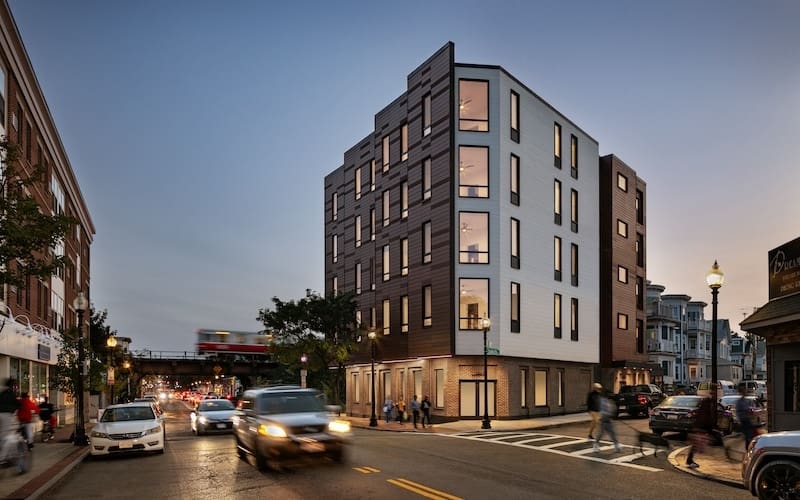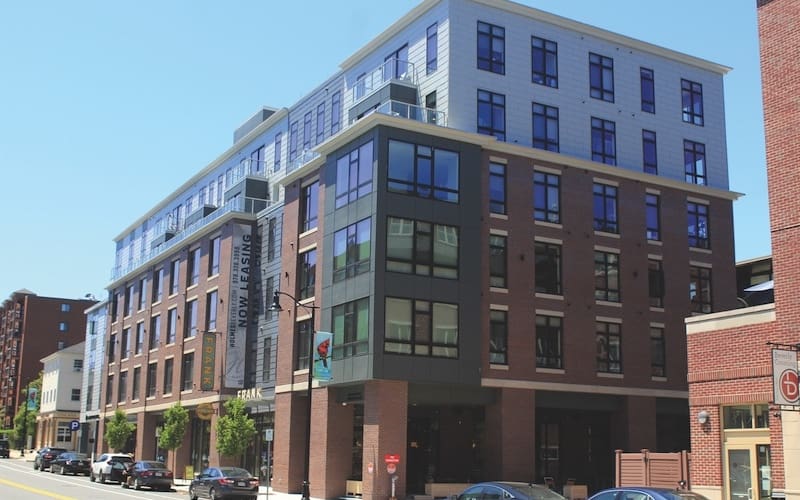
Dot Crossing is an eco-conscious building that puts families, neighborhoods, and the planet first. Image: Courtesy J. Garland Enterprises
In early 2024, a new housing development opened at 1463 Dorchester Avenue – a stone’s throw from the Fields Corner MBTA station. The development arose on a formerly vacant parcel in the historic, ethnically diverse, and economically vibrant Boston neighborhood. All 29 new, moderately priced apartments are energy-efficient, featuring rooftop solar panels, all-electric appliances, and energy-saving heating and cooling systems to keep utility costs low.
Known as “Dot Crossing,” the Fields Corner development is precisely the affordable, climate-friendly housing we need. Although it relied heavily on state and municipal funding for its construction, private investors and the power of incentives helped make it a reality.
In an era in which the federal government is abandoning climate goals and efficiency incentives, Dot Crossing offers a glimpse of how private financial markets can help build economical, climate-smart, and healthier housing. Market tools can attract investors seeking a financial return, and incentive-based strategies can provide viable funding for projects in towns and cities that struggle to cope with dwindling federal grants. As communities grapple with housing shortages and an affordability crisis, private markets can offer help. While markets alone can’t solve these issues, they have already proven they can be part of the solution.
Private Investment in Action
Dot Crossing received financial support from the Healthy Neighborhoods Equity Fund II (HNEF II), an investment fund dedicated to developing climate-friendly, healthy housing in neighborhoods that investors have traditionally viewed as high-risk. The fund was born of a partnership between CLF and the Massachusetts Housing Investment Corporation (MHIC), New England’s largest and oldest nonprofit affordable housing investor. Together, we have built an investment model to change how developers site, design, and build housing.
HNEF funds are available when developers build projects serving low-, moderate-, and middle-income residents within a half mile of public transit that meet a range of environmental, social, and economic criteria. This kind of funding can be a critical piece of the puzzle for developments ineligible for federal and state subsidies supporting low-income housing.
Dot Crossing is a prime example of how well it can work. The five-story building is home not only to 29 families but to the Words as Worlds bookstore, owned by the City of Boston’s poet laureate, Porsha Olayiwola. The neighborhood is a vibrant multicultural mix next to the MBTA’s Red Line. Incomes in the area, on average, are lower than in many other parts of Boston.
The development mirrors other projects financed by Healthy Neighborhood Equity Funds. So far, the funds (in three iterations that include HNEF I, II, and III) have helped finance 15 climate-smart, transit-oriented, mixed-income housing developments in Massachusetts, creating 927 homes. These projects stand out in a landscape of multimillion-dollar condos and an ongoing housing crisis for low- and middle-income residents.

Keeping Climate in Mind
Back in the heart of the Fields Corner business district, Dot Crossing residents are so close to public transit that they can easily swap car trips for public transit commutes. In New England, transportation makes up over 40% of climate-warming emissions but residents across the Fund’s projects won’t need to rely on cars so much, so they won’t contribute as much to the carbon pollution overheating our planet.
Many Healthy Neighborhood Equity Funds’ investments repurpose abandoned buildings or are located on formerly contaminated lots. More than half of the invested properties are designed specifically to address energy efficiency, featuring solar-ready rooftops and on-site electric vehicle charging stations. Rents are kept accessible, and energy-efficient designs keep monthly utility expenses low.
While residents enjoy the benefits of walkable, affordable housing, investors get a modest financial return, along with other positive environmental, economic, health, and social impacts.
Profitable Investing for Good
Given our need for more affordable and climate-friendly housing, CLF and MHIC are currently raising capital to launch a third Healthy Neighborhood Equity Fund. In the meantime, HNEF II is continuing to invest in building healthy, thriving, resilient neighborhoods. The fund’s largest investment to date was in Pawtucket, Rhode Island, where CLF and MHIC made an $8.35 million investment to build 150 new units of all-electric housing. When the $55 million project is complete, it will also boast commercial spaces and easy walking access to the new Pawtucket-Central Falls commuter rail station and downtown Pawtucket. Residents will be encouraged to get out and walk to nearby shops which will bolster their physical health. And they’re more likely to meet neighbors and make friends, which will improve their mental health.
Our innovative funding model demonstrates how investments can attract private capital, provide reliable financial returns, and promote positive social, environmental, health, and economic change in lower- and moderate-income communities.
In this era of retrenchment in which federal funding for climate-smart projects and energy efficiency is being slashed, the markets and incentive strategies may be key. This is especially true if states and cities still hope to reduce carbon emissions to zero by 2050.
New England must begin to adopt greener, more sustainable building practices. Until we pass building codes and zoning reforms to lessen climate impacts, incentive-based strategies offer an alternative approach to shifting the building paradigm while addressing our affordability crisis.
Gina Foote is Conservation Law Foundation’s Director of Impact Investment.



